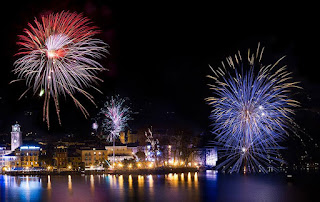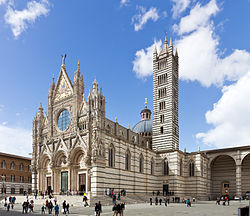Distinguished soldier was interested in art and science
Mattias de’ Medici, who was an enthusiastic supporter of the Palio horse race during his time as Governor of Siena, died on this day in 1667.
A portrait of Mattias de' Medici by
the court painter, Justus Sustermans
He is remembered for being a patron of art and of science and for the scientific instruments he acquired while on military campaigns during the Thirty Years War in Germany, which are now housed in the Uffizi galleries in Florence.
Mattias, who was born in 1613, was the third son of Grand Duke Cosimo II de' Medici of Tuscany and of Archduchess Maria Maddalena of Austria.
He was originally intended for the church, but he had little enthusiasm for the ecclesiastical life and so from the age of 16, he pursued a military career instead.
After Cosimo II died in 1621, he was succeeded as Grand Duke by Matteo’s older brother, Ferdinando. Grand Duke Ferdinando II appointed Mattias as the Governor of Siena, to replace their aunt, Caterina de’ Medici, who had been governor of the city until her death in 1629.
After he arrived in Siena, Mattias took up residence in the Royal Palace in Piazza del Duomo and he quickly became very popular with the people living in the city.
He took part in the Battle of Lutzen in 1632, during the Thirty Years War in Germany. After he returned to Siena, he ruled the city again before becoming involved in the Wars of Castro.
 |
| A portrait of Mattias in military uniform |
As a reward for his military victories, his brother, Ferdinando, presented Mattias with the Villa of Lappeggi in a beautiful area of countryside near Florence.
Mattias was an enthusiastic supporter of the arts and he became a keen collector. He was the patron of Justus Sustermans, the Flemish court painter of the Medici family, and of Baldassare Franceschini, who was also known as Il Volteranno.
His interests centred on painting, and he paid for the training of Livio Mehus, a Flemish painter, draughtsman and engraver, many of whose works are listed in an inventory of Mattias’s possessions made in 1669. As a soldier, Mattias was particularly interested in battle painting, and the artist Giacomo Cortese, who, like Mattias, had experienced military combat, was employed by him in the 1650s.
Mattias was said to have been delighted with four paintings of battles in which he had fought himself, which have been identified in a room in the Villa of Lappeggi. This room also contains a damaged fresco, which has been identified as Victory and Fame by Franceschini.
Mattias promoted Siena’s famous Palio during its early history and a horse from his stable regularly took part in the event.
During his time in Germany, he acquired many scientific instruments, such as dials, astrolabes, quadrants, and compasses, which were given to the Uffizi gallery.
Mattias never married and as he got older, he suffered from gout. He was considering re-entering the church, but illness prevented it. He died in Siena in 1667 at the age of 54. He was buried in the Medici family tombs in the Basilica of San Lorenzo in Florence.
His embalmed body was exhumed in 1857 during an investigation into the Medici remains in the church. He was found dressed as a Knight of Malta in black velvet, wearing velvet shoes and with a gold medal on his chest.
Travel tip:
The Palio di Siena still attracts huge crowds
to witness the event in Piazza del Campo
The Palio di Siena is a horse race that takes place in the Piazza del Campo in Siena twice each year, on 2 July and 16 August. Ten horses and bareback riders, who are dressed in the colours of their districts, represent 10 of the 17 contrade, or city wards, in a competition that dates back to 1633, when it was inaugurated soon after Mattias de’ Medici became governor of the city. The 10 participants race each other on a temporary dirt track around the perimeter of the shell-shaped piazza. The race consists of three laps, which the horses cover at such a furious pace that the whole thing is over in about 90 seconds. It is not uncommon for riders to fall off but a riderless horse can still be declared the winner if the colours of their contrada are still attached to the bridle.
Travel tip:
The Basilica di San Lorenzo in Florence, which
houses the tombs of the Medici family
The Basilica of San Lorenzo, where Mattias de’ Medici is buried, is one of the largest churches in Florence. It is at the centre of the main market district of the city, and is the burial place of all the principal members of the Medici family. It is one of several churches that claim to be the oldest in Florence, having been consecrated in 393 AD, at a time when it stood outside the city walls. For hundreds of years it was the city's cathedral, before the Cathedral of Santa Maria del Fiore was completed in the 15th century. In 1419, Giovanni di Bicci de' Medici - father of Cosimo de’ Medici, the founder of the banking dynasty - offered to finance a new church to replace an 11th-century Romanesque building. Filippo Brunelleschi, the leading Renaissance architect of the first half of the 15th century, famous for the colossal dome of Santa Maria del Fiore, was commissioned to design it, although it was not completed until after his death.
Also on this day:
1815: The birth of adventurer Pierre-Napoleon Bonaparte
1896: The birth of composer and lyricist Cesare Andrea Bixio
2014: The death of soprano Anna Cerquetti

.jpg)






.jpg)











